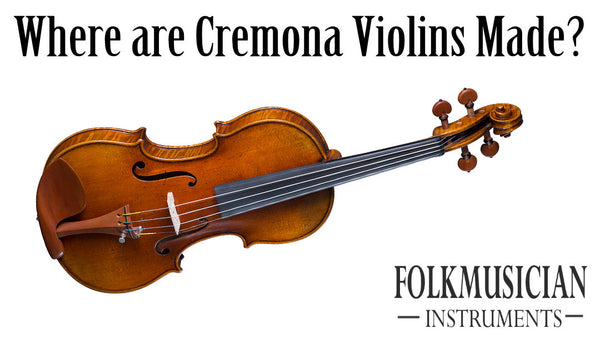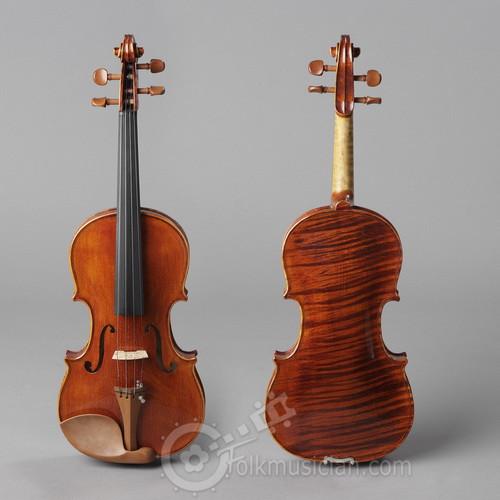Choosing Your Violin
Now that you have an idea of what goes into the making of a violin, your next step is deciding what price range you will be shopping for. For all but a few players, a compromise is going to be necessary. You have already taken the first step toward getting the best possible violin for the money. The best way to maximize your money is to buy online. Online shops have broken price barriers and offer good deals on violins and leveled the field from the largest cities to the smallest rural towns. Even with online pricing, you need to be realistic about what you expect.
It should be noted that we are using internet prices as our guidelines. You should not expect to find these same prices at local stores. It will be much higher if purchased from a local shop.
Under $100:
These are the lowest grade violins made. The best advise we can give, is to not buy one, no matter how good the description sounds.
Opinions vary greatly on instruments in this range (actually, you find people arguing about violins of every grade). They are often called VSO (Violin shaped object). Meaning they look like a violin but do not play or sound like a violin.
While some teachers may allow them, few teachers approve, and some will refuse to teach a student with instruments of this grade.
No matter what your thoughts on them, violins in this range are the lowest quality made. It can get the player started, give parents a chance to see if the child is really interested or just make a good decoration. It will eventually need to be upgraded though (unless of course it is just a decoration). Ideally, they should be avoided. Under $100 you rarely find ebony fingerboards, good bows, quality rosins, etc.
$150:
Around $150 you are out of the lowest grade violins. This brings you to the next level up. You will find some ok violins in this price range. They are not going to sound real good, they are still lacking in areas like string quality, but they will be a major improvement over the $100 violins. You will be seeing ebony fingerboards and ebony or boxwood fittings in this range. If possible jump up to the next level. Consider these barely adequate for the beginner.
$250:
When you are buying in the lower price ranges, $50 can make a big difference. From here on up the specs on the violins will be real close to one another. This does not mean the violins themselves are the same, just the basic specs. Most violins will have flamed backs and sides. The quality of the violin is improved. The tone is more inline with how a violin is supposed to sound. They feel different, having better balance and being lighter. The instrument will be more responsive. The shop selling the instrument has a much better base for the setup work. Violins in this range make a nice beginner outfit. They are not suited to intermediate players.
At $500-$1000 you get into the violins that most casual players will consider as their last violin. It may not be their dream violin, but it is good enough and they can not often justify spending more.
Our guide is concentrating on the lower spectrum of violins. We assume that most players shopping for expensive violins have been playing long enough to have a good idea of what they are looking for.
Other things to ponder:
Violins sound better with time. New violins need to “open up” this means as the violin is played the wood breaks in. Over the first few weeks the violin will improve. Not drastically. Violins continue to improve over the years. This occurs at a much slower rate than the opening up period. In 5 years a violin will sound noticeably better.
Violins in the $500 and under ranges are often equipped with low grade strings. In the $200 and under you find very low grade strings. This leads to the option of getting a cheaper violin and adding good strings. This is a good idea and is a great way to maximize your bang for the buck, but don’t put $60 strings on your $100 violin. $60 strings on your $250 violin might work out well.
The bow is very important to the violin`s tone. Upgrading the bow is a great way to get the best possible tone from your violin. Having a $200 bow that you use on a $200 violin is not as crazy as it seems.
Violin outfits almost always include rosin. These are often very low grade rosins. There is no better place to invest money than the rosin. It is cheap, can provide drastic improvements and lasts years. No matter what violin you choose, there is no excuse for not getting good quality rosin.
As for the bow and strings… We recommend spending as much as possible on your basic violin outfit. This will be the base that you build on later. When budget permits, or skill level requires it, upgrade the strings. The same goes for the bow. A bow can be kept when you move on to a higher grade violin. A good bow is never a waste.
Lastly, we want to point out the importance of the setup performed on the violin. This ranges from next to nothing being done, to many hours spent fine tuning the violin. This is normally in line with the pricing and discounting of the instrument. You should not expect to find heavily discounted prices and a good setup even if you are purchasing a high-end instrument. Example: A $2000 (retail violin) sold at $1000 will not likely have a good setup. A low end violin being sold at a very low price will only have enough done to make it playable. It would be a waste to spend $100 on a really good setup for an instrument of this level. Granted it would sound and play better, but it defeats the purpose of getting a cheap violin. If you have a $200+ violin that you like and you plan to get a better bow, and upgrade the strings. Look into having a good setup done. It will be costly but the end result can be a violin that sounds and plays better than many violins costing more. You will no longer be playing a $200 violin. All these things go hand in hand. It creates endless options and makes shopping even more difficult, but it is important if you want to end up with a well rounded outfit at a reasonable price.
We sell hundreds of violins per month. Because of this we have learned a lot from our customers. Our most commonly returned products are the under $100 violins. We continue to sell them as they do serve the purpose of giving people the chance to try the violin who otherwise could not afford to play.
Try not to shop by price alone. This cannot be said enough. If you can afford a better violin, avoid the low grade instruments. In the long run, the money you saved buying the cheap violin may cause a lot of frustration. This goes for the model as well as the dealer. Dealers with the lowest prices will more often than not sell violins with a poor setup.
What is the lowest priced violin we recommend?
In our opinion, the Scotti Violin offers the best value in the lower price ranges. Spend less than this and the quality drops quickly.
At Folkmusician, all of our violins are setup correctly using the MENC specifications. We know the importance of a good setup, and will not cut corners. You may pay a little more when you buy from Folkmusician, but it is money well spent.
Leave a comment
Comments will be approved before showing up.
Also in Fiddle-Violin


